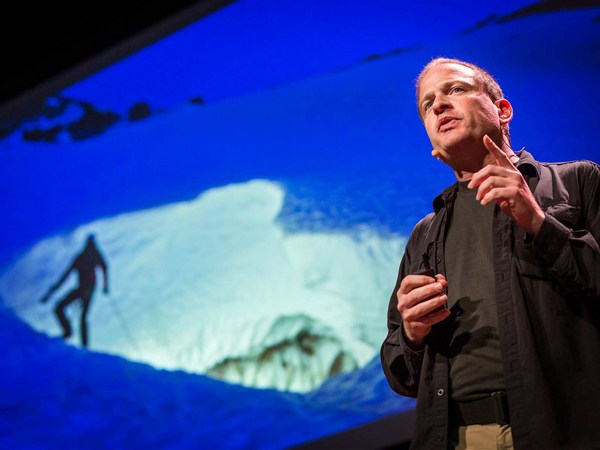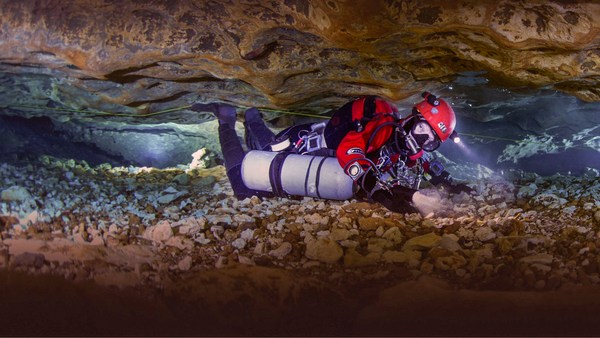I would like to invite you to come along on a visit to a dark continent. It is the continent hidden under the surface of the earth. It is largely unexplored, poorly understood, and the stuff of legends. But it is made also of dramatic landscapes like this huge underground chamber, and it is rich with surprising biological and mineralogical worlds.
Thanks to the efforts of intrepid voyagers in the last three centuries -- actually, we know also thanks to satellite technology, of course -- we know almost every single square meter of our planet's surface. However, we know still very little about what is hidden inside the earth. Because a cave landscape, like this deep shaft in Italy, is hidden, the potential of cave exploration -- the geographical dimension -- is poorly understood and unappreciated. Because we are creatures living on the surface, our perception of the inner side of the planet is in some ways skewed, as is that of the depth of the oceans or of the upper atmosphere.
However, since systematic cave exploration started about one century ago, we know actually that caves exist in every continent of the world. A single cave system, like Mammoth Cave, which is in Kentucky, can be as long as more than 600 kilometers. And an abyss like Krubera Voronya, which is in the Caucasus region, actually the deepest cave explored in the world, can go as far as more than 2,000 meters below the surface. That means a journey of weeks for a cave explorer.
Caves form in karstic regions. So karstic regions are areas of the world where the infiltrating water along cracks, fractures, can easily dissolve soluble lithologies, forming a drainage system of tunnels, conduits -- a three-dimensional network, actually. Karstic regions cover almost 20 percent of the continents' surface, and we know actually that speleologists in the last 50 years have explored roughly 30,000 kilometers of cave passages around the world, which is a big number. But geologists have estimated that what is still missing, to be discovered and mapped, is something around 10 million kilometers.
That means that for each meter of a cave that we already know, that we have explored, there are still some tens of kilometers of undiscovered passages. That means that this is really an endless continent, and we will never be able to explore it completely. And this estimation is made without considering other types of caves, like, for example, inside glaciers or even volcanic caves, which are not karstic, but are formed by lava flows. And if we have a look at other planets like, for example, Mars, you will see that this characteristic is not so specific of our home planet. However, I will show to you now that we do not need to go to Mars to explore alien worlds.
I'm a speleologist, that means a cave explorer. And I started with this passion when I was really young in the mountains not far from my hometown in North Italy, in the karstic regions of the Alps and the Dolomites. But soon, the quest for exploration brought me to the farthest corner of the planet, searching for new potential entrances of this undiscovered continent. And in 2009, I had the opportunity to visit the tepui table mountains, which are in the Orinoco and Amazon basins. These massifs enchanted me from the first time I saw them. They are surrounded by vertical, vertiginous rock walls with silvery waterfalls that are lost in the forest. They really inspired in me a sense of wilderness, with a soul older than millions and millions of years. And this dramatic landscape inspired among other things also Conan Doyle's "The Lost World" novel in 1912. And they are, really, a lost world. Scientists consider those mountains as islands in time, being separated from the surrounding lowlands since tens of millions of years ago. They are surrounded by up to 1,000-meter-high walls, resembling a fortress, impregnable by humans. And, in fact, only a few of these mountains have been climbed and explored on their top.
These mountains contain also a scientific paradox: They are made by quartz, which is a very common mineral on the earth's crust, and the rock made up by quartz is called quartzite, and quartzite is one of the hardest and least soluble minerals on earth. So we do not expect at all to find a cave there. Despite this, in the last 10 years, speleologists from Italy, Slovakia, Czech Republic, and, of course, Venezuela and Brazil, have explored several caves in this area. So how can it be possible?
To understand this contradiction, we have to consider the time factor, because the history of the tepuis is extremely long, starting about 1.6 billion years ago with the formation of the rock, and then evolving with the uplift of the region 150 million years ago, after the disruption of the Pangaea supercontinent and the opening of the Atlantic Ocean. So you can imagine that the water had tens or even hundreds of millions of years to sculpt the strangest forms on the tepuis' surfaces, but also to open the fractures and form stone cities, rock cities, fields of towers which are characterized in the famous landscape of the tepuis. But nobody could have imagined what was happening inside a mountain in so long a time frame.
And so I was focusing in 2010 on one of those massifs, the Auyán-tepui, which is very famous because it hosts Angel Falls, which is the highest waterfall in the world -- about 979 meters of vertical drop. And I was searching for hints of the existence of cave systems through satellite images, and finally we identified an area of collapses of the surface -- so, big boulders, rock piles -- and that means that there was a void below. It was a clear indication that there was something inside the mountain.
So we did several attempts to reach this area, by land and with a helicopter, but it was really difficult because -- you have to imagine that these mountains are covered by clouds most of the year, by fog. There are strong winds, and there are almost 4,000 millimeters of rainfall per year, so it's really, really difficult to find good conditions. And only in 2013 we finally landed on the spot and we started the exploration of the cave.
The cave is huge. It's a huge network under the surface of the tepui plateau, and in only ten days of expedition, we explored more than 20 kilometers of cave passages. And it's a huge network of underground rivers, channels, big rooms, extremely deep shafts.
So it's really an incredible place. And we named it Imawarì Yeuta. That means, in the Pemón indigenous language, "The House of the Gods." You have to imagine that indigenous people have never been there. It was impossible for them to reach this area. However, there were legends about the existence of a cave in the mountain. So when we started the exploration, we had to explore with a great respect, both because of the religious beliefs of the indigenous people, but also because it was really a sacred place, because no human had entered there before. So we had to use special protocols to not contaminate the environment with our presence, and we tried also to share with the community, with the indigenous community, our discoveries.
And the caves represent, really, a snapshot of the past. The time needed for their formation could be as long as 50 or even 100 million years, which makes them possibly the oldest caves that we can explore on earth. What you can find there is really evidence of a lost world.
When you enter a quartzite cave, you have to completely forget what you know about caves -- classic limestone caves or the touristic caves that you can visit in several places in the world. Because what seems a simple stalactite here is not made by calcium carbonate, but is made by opal, and one of those stalactites can require tens of millions of years to be formed. But you can find even stranger forms, like these mushrooms of silica growing on a boulder. And you can imagine our talks when we were exploring the cave. We were the first entering and discovering those unknown things, things like those monster eggs. And we were a bit scared because it was all a discovery, and we didn't want to find a dinosaur. We didn't find a dinosaur.
(Laughter)
Anyway, actually, we know that this kind of formation, after several studies, we know that these kinds of formations are living organisms. They are bacterial colonies using silica to build mineral structures resembling stromatolites. Stromatolites are some of the oldest forms of life that we can find on earth. And here in the tepuis, the interesting thing is that these bacteria colonies have evolved in complete isolation from the external surface, and without being in contact with humans. They have never been in contact with humans. So the implications for science are enormous, because here you could find, for example, microbes that could be useful to resolve diseases in medicine, or you could find even a new kind of material with unknown properties. And, in fact, we discovered in the cave a new mineral structure for science, which is rossiantonite, a phosphate-sulfate.
So whatever you find in the cave, even a small cricket, has evolved in the dark in complete isolation. And, really, everything that you can feel in the cave are real connections between the biological and the mineralogical world. So as we explore this dark continent and discover its mineralogical and biological diversity and uniqueness, we will find probably clues about the origin of life on our planet and on the relationship and evolution of life in relationship with the mineral world. What seems only a dark, empty environment could be in reality a chest of wonders full of useful information.
With a team of Italian, Venezuelan and Brazilian speleologists, which is called La Venta Teraphosa, we will be back soon to Latin America, because we want to explore other tepuis in the farthest areas of the Amazon. There are still very unknown mountains, like Marahuaca, which is almost 3,000 meters high above sea level, or Aracà, which is in the upper region of Rio Negro in Brazil. And we suppose that we could find there even bigger cave systems, and each one with its own undiscovered world.
Thank you.
(Applause)
Bruno Giussani: Thank you, Francesco. Give me that to start so we don't forget. Francesco, you said we don't need to go to Mars to find alien life, and indeed, last time we spoke, you were in Sardinia and you were training European astronauts. So what do you, a speleologist, tell and teach to the astronauts?
Francesco Sauro: Yeah, we are -- it's a program of training for not only European, but also NASA, Roskosmos, JAXA astronauts, in a cave. So they stay in a cave for about one week in isolation. They have to work together in a real, real dangerous environment, and it's a real alien environment for them because it's unusual. It's always dark. They have to do science. They have a lot of tasks. And it's very similar to a journey to Mars or the International Space Station.
BG: In principle. FS: Yes.
BG: I want to go back to one of the pictures that was in your slide show, and it's just representative of the other photos --
Weren't those photos amazing? Yeah?
Audience: Yeah!
(Applause)
FS: I have to thank the photographers from the team La Venta, because all of those photos are from the photographers.
BG: You bring, actually, photographers with you in the expedition. They're professionals, they're speleologists and photographers. But when I look at these pictures, I wonder: there is zero light down there, and yet they look incredibly well-exposed. How do you take these pictures? How do your colleagues, the photographers, take these pictures?
FS: Yeah. They are working in a darkroom, basically, so you can open the shutter of the camera and use the lights to paint the environment.
BG: So you're basically --
FS: Yes. You can even keep the shutter open for one minute and then paint the environment. The final result is what you want to achieve.
BG: You spray the environment with light and that's what you get. Maybe we can try this at home someday, I don't know.
(Laughter)
BG: Francesco, grazie. FS: Grazie.
(Applause)





